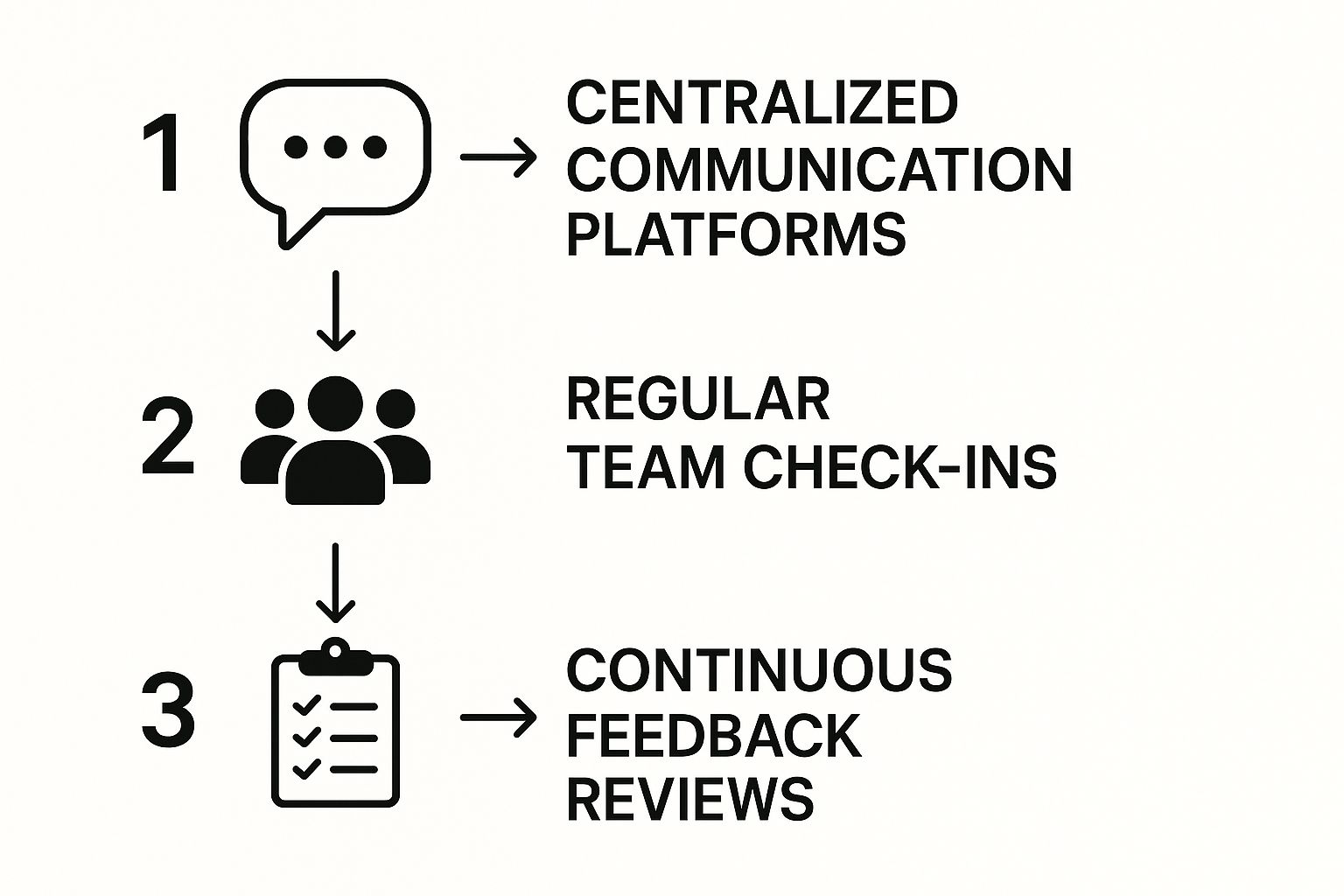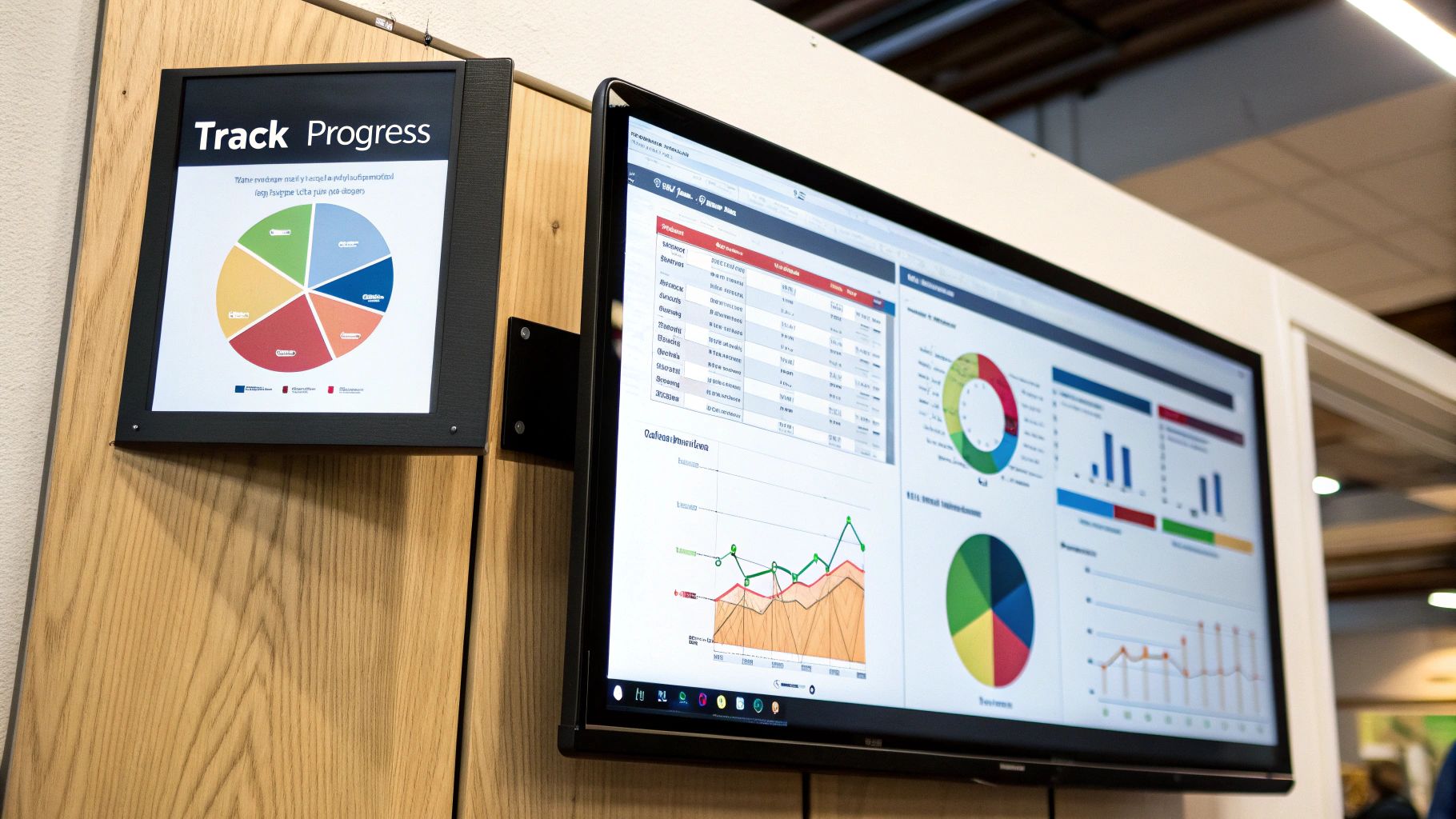Improving Internal Communication: Top Strategies to Boost Team Engagement
Getting internal communication right means building a system where information actually flows, not just gets blasted out. It's about moving past the standard email newsletter and creating a strategy that genuinely connects with everyone in the company. When you nail it, you'll see a real shift in morale, alignment, and productivity. It's the difference between employees feeling confused and feeling like they're part of something with a clear purpose.
Why Your Communication Strategy Isn't Connecting

Let’s be real for a minute. That weekly all-staff email you spend hours crafting? It’s probably not making the splash you think it is. Too many organizations fall into the trap of believing that sending information is the same as communicating it. In reality, that assumption leads to disengaged teams and a ton of unnecessary friction.
The signs of a failing communication strategy can be subtle at first. You might see different departments working in total isolation, accidentally duplicating projects because no one knew what the other was doing. Or maybe you've noticed that dead-silent, crickets-chirping vibe during company meetings where no one asks questions. These aren't just random problems—they're direct symptoms of information not getting to the right people.
The Frontline Worker Disconnect is Real
This issue hits non-desk and frontline employees the hardest. While your office staff lives in email and Slack, the people on the factory floor, in the warehouse, or out in the field are often completely disconnected. They miss out on everything from major company news and strategy pivots to simple things like celebrating a team win.
This creates a painful divide—a two-tiered system where one group feels in the know and valued, while the other feels forgotten. A 2025 international study on employee communication put some hard numbers on this gap. It found that only 29% of non-desk employees felt satisfied with the communication they received. That’s a world away from the 47% satisfaction rate among their desk-based colleagues.
When people can't see how their day-to-day work connects to the bigger company mission, they check out. This disconnect isn't just a shame; it's a primary cause of low morale and disengagement.
It's More Than a "Nice-to-Have"
For far too long, internal communication has been treated like a soft skill or a side project for HR. That mindset needs to change. Solid communication is a core business function, plain and simple. It's the operational backbone that makes a company resilient and agile, ensuring everyone from the C-suite to the newest hire is on the same page and can roll with the punches.
Taking a hard look at the importance of an effective communication strategy at work is the first real step. A great strategy delivers tangible results:
- Goal Clarity: Everyone knows what the company is aiming for and how their role fits into that picture.
- Productivity Boost: Teams stop wasting time hunting for information or redoing work that's already been done.
- Higher Morale: Employees feel respected, trusted, and genuinely connected to the company culture.
- Smarter Decisions: When people have the right information, they're empowered to make better choices on their own.
Before you rush off to launch a new app or another channel, you have to diagnose what’s broken first. Figuring out why your current approach isn't working is the only way to build something that finally will.
Pinpointing Where Communication Is Breaking Down
Before you can start building a better communication system, you first have to figure out where the old one is failing. And let's be honest, guessing just won’t cut it. To make any real headway, you’ve got to get on the ground and see what your employees are actually dealing with every day.
This means rolling up your sleeves and conducting a full-on communication audit. Think of yourself as a detective. Your job is to find the clues—the information bottlenecks, the misused channels, the sheer exhaustion from too many messages. The goal isn’t about pointing fingers; it’s about gathering the real-world evidence you need to build a strategy that truly serves everyone, from the front lines to the C-suite.
Going Deeper Than a Simple Satisfaction Survey
I’ve seen it a hundred times. The first instinct is to blast out a company-wide survey asking, "How satisfied are you with our communication?" While that might give you a number, it doesn't give you a story. It only scratches the surface. To get data you can actually do something with, you need to ask sharper, more specific questions that uncover how people are really behaving.
A good diagnostic survey should tell you:
- Where do people actually look for info? Forget what you think they do. Find out if they rely on email, a chat app like Slack, the company intranet, or if they’re just getting everything from their manager.
- What are they missing? Do they feel left in the dark about company performance? Are team goals a mystery? Or do they just want a little recognition for their hard work?
- Is everyone overwhelmed? Pinpoint which channels are creating the most noise. Are people drowning in emails or getting pinged to death with notifications? Knowing this is key to streamlining later.
- How visible is leadership? Do your people feel connected to the company’s leaders? It’s crucial they understand the "why" behind big decisions.
Asking these kinds of questions turns a generic poll into a powerful diagnostic tool. You go from having a vague satisfaction score to a detailed map of exactly what needs fixing.
The process of finding and fixing these issues isn’t a one-and-done project. It's a continuous cycle of listening to your team, taking action, and then checking back in to see how it's working.

This feedback loop is what separates good communication strategies from great ones.
The Power of Real Conversations
Numbers from a survey tell you what is happening. It’s the conversations that tell you why. This is where you find the rich, human context that data alone will never give you.
Pulling together small focus groups with different cross-sections of your company—think new hires, seasoned veterans, or frontline managers—can uncover some incredible insights. The trick is to create an environment where people feel safe enough to be brutally honest. Ditch the formal Q&A and frame it as a brainstorming session.
Try asking open-ended questions like:
- "Walk me through how you found out about our last big company announcement."
- "If you had a magic wand, what's the one thing you'd change about how you get information here?"
One of my biggest takeaways over the years? Never underestimate the power of a casual, one-on-one chat. The frustrations and brilliant ideas that come up in a quick conversation with a team lead are often the ones that never make it into an official survey.
For a structured approach to your audit, this checklist can help ensure you don't miss any critical areas.
Internal Communication Audit Checklist
This checklist is a step-by-step guide to help you conduct a thorough internal audit, making sure you cover all the essential aspects of your company's communication effectiveness.
| Audit Area | Key Questions to Ask | Data Collection Method |
|---|---|---|
| Channel Effectiveness | Which channels are used most? Which are ignored? Are we using the right tool for the right message? | Employee Surveys, Analytics from Digital Channels |
| Message Clarity | Are messages easy to understand? Is the tone appropriate? Do employees know what action to take? | Focus Groups, Content Review |
| Leadership Communication | Is leadership visible and accessible? Are company goals and vision clearly communicated? | Executive Interviews, All-Hands Q&A Analysis |
| Team & Peer Communication | Do team members feel they can speak openly? Are cross-departmental communications effective? | Team Meetings, One-on-One Interviews |
| Feedback Mechanisms | Do employees feel heard? Are there clear, safe channels for providing feedback and asking questions? | Survey Questions, Review of Suggestion Box/HR Data |
By systematically working through these areas, you can build a comprehensive picture of your communication landscape.
Listening is more than just hearing words; it's about understanding the feeling and intent behind them. It requires real empathy. If you want to sharpen this skill, we've put together some practical exercises in our guide on active listening activities to boost team communication.
When you combine the hard data from your surveys with the human stories from these conversations, you build an unshakeable, evidence-based foundation. You’ll have a clear diagnosis of your organization’s unique challenges, ready to move forward with solutions that solve real problems, not just the ones you think you have.
Matching Your Message to the Right Channel
Once you've figured out where communication is breaking down, it's time to build a multi-channel strategy that actually gets the job done. Relying solely on a company-wide email is like trying to build a house with just a hammer. You might make some noise, but you won't build anything sturdy.
The real key to improving internal communication is picking the right tool for the right job, every single time. This isn't about adding more apps for the sake of it; it's about creating a smart system where every channel has a crystal-clear purpose.
Moving Beyond the One-Size-Fits-All Email
For years, email was the default for everything. That era is over. While it still has a place for formal announcements or lengthy policy documents, it’s a terrible choice for urgent news or sparking a quick conversation. In fact, leaning too heavily on email is a surefire way to create information overload, burying critical updates in a mountain of unread messages.
A modern approach means recognizing that different messages need different vehicles. A quick project update doesn't warrant a formal email. A simple ping in a dedicated chat channel is faster, more direct, and frankly, more respectful of everyone's time.
Here's the core principle I've seen work time and again: match the urgency of your message to the speed of the channel. Don't send a five-paragraph email for something that could have been a 10-second chat.
Building Your Multi-Channel Communication Stack
An effective communication "stack" is all about layering different tools to serve specific needs. When each tool has a defined role, employees aren't left guessing where to look for information. It just makes sense.
Here’s how I typically see these channels break down in successful organizations:
- Instant Messaging (Slack, Microsoft Teams): This is for the now. Think quick questions, real-time problem-solving, and informal team chatter. It's the digital equivalent of tapping a coworker on the shoulder.
- Dedicated Employee Apps: These are a game-changer for reaching your non-desk and frontline folks. It’s their mobile "single source of truth" for company news, resources, and updates—all on the device they already use.
- Intranet or Hub: This is your company's digital library. It’s the perfect home for evergreen content that doesn't change often, like the employee handbook, benefits information, and org charts.
- SMS Alerts: Use these sparingly and only for true emergencies or critical operational updates. A sudden facility closure or an urgent safety warning is a perfect use case. The nearly 100% open rate makes it invaluable when a message absolutely must be seen.
- Digital Signage: Don't underestimate the power of a well-placed screen in a break room or on a factory floor. It's fantastic for reinforcing key messages, celebrating team wins, and sharing safety reminders with your non-wired workforce.

You can see how a tool like Slack is built for targeted, immediate conversations with its organized channels—a world away from the chaos of a company-wide inbox.
Real-World Scenarios in Action
This is where the rubber meets the road. A sales team that's constantly traveling has completely different communication needs than an engineering team sitting in the office.
Let's look at a few practical examples:
- The Distributed Sales Team: These folks live on their phones. A mobile-first employee app becomes their lifeline for product updates and sales collateral. A dedicated chat channel also lets them share instant feedback and wins from the field.
- The Manufacturing Plant: Workers on the floor aren't glued to a computer. Digital signage in the break room is how they see safety updates and production goals. If a machine goes down, an SMS alert to shift supervisors gets immediate action.
- The Hybrid Corporate Office: For employees splitting time between home and the office, you need a flexible mix. The intranet holds the long-term resources, but a platform like Slack or Teams keeps daily collaboration flowing, no matter where anyone is working.
The secret is to get into the weeds of each employee group's daily workflow and meet them where they are. Forcing a frontline worker to log into a clunky desktop portal they never use is a recipe for failure.
By thoughtfully curating your channels, you give every message the best possible chance of being seen, understood, and acted upon. This strategic approach is how you truly start improving internal communication across your entire organization.
Crafting Messages People Actually Want to Read
Getting the right communication channels set up is a great start, but it's only half the battle. If the messages you’re sending are robotic, irrelevant, or just plain confusing, even the slickest new app won't save your strategy. The real magic happens when you master the art of crafting content that connects with people, not just broadcasting corporate announcements.
These days, employees expect more than just a data dump. They're looking for authenticity and a real human connection. A generic, jargon-stuffed memo from "Corporate Headquarters" doesn't exactly build trust or get anyone excited. In fact, it does the opposite—it creates distance. The messages that truly land are the ones that sound like they were written by a person, for a person.
This means dropping the overly formal tone and starting to write with a bit of empathy. Before you type a single word, put yourself in their shoes. What do they really need to know? And more importantly, why should they care? Answering those two questions is the secret to turning a forgettable update into something that actually sticks.
Write Like a Human
What does a human voice sound like? It’s clear, direct, and genuine. It uses simple language, steers clear of corporate-speak, and isn't afraid to show a little personality. This is absolutely critical when it comes to messages from leadership. When leaders communicate with an authentic voice, it helps break down those invisible walls of hierarchy and fosters a genuine sense of "we're all in this together."
This approach is even more important when you're navigating tricky subjects. The ground is shifting under our feet, and employees are increasingly demanding transparency on tough topics. Axios HQ reported that workers want more open, organization-wide discussions on everything from DEI and politics to return-to-office policies. Leaders who lean into these conversations are the ones who build real, lasting trust.
Think of it this way: imagine you’re explaining a new policy or a big company change to a friend over coffee. You'd be direct. You'd guess what questions they'd ask. And you’d be honest about the challenges. That’s the tone that builds credibility.
Building that credibility is everything. If you want to go deeper on this, our guide on how to build trust in teams offers some really practical steps for creating that kind of open environment.
Make It Personal with Stories
A one-size-fits-all message rarely fits anyone well. The simple act of segmenting your audience and tailoring the content makes it instantly more relevant and powerful. An update for your engineering team should feel completely different from one sent to the sales team, even if the core message is the same.
Here are a few simple ways to make your content feel more personal:
- Use Role-Specific Scenarios: When explaining a new workflow, frame it with an example that a specific department would actually run into in their day-to-day.
- Address Teams by Name: Instead of a generic "Hello, all," try addressing messages to the specific groups they’re meant for. It’s a small change that makes a big difference.
- Celebrate Local Wins: Shine a spotlight on successes that are meaningful to a particular office, team, or region.
Beyond just personalizing, storytelling is probably the most powerful tool in your entire toolkit. We're all wired for stories. We remember them far better than we remember dry facts and figures. So instead of just stating a new company goal, tell the story behind it.
For example, instead of this:
"Our Q4 objective is to increase customer retention by 15%."
Try telling the story:
"Last week, our support team helped a long-time customer, Sarah, solve a problem she’d been wrestling with for days. She was so relieved she sent a note saying our help made her a 'customer for life.' That's what this is all about. This quarter, our goal is to create more 'Sarah' moments by focusing on initiatives that will boost our customer retention by 15%."
See the difference? The second version connects a business metric to a real human outcome, giving it meaning and a personal touch.
Spark a Real Conversation
Finally, great internal communication is never a monologue—it's a dialogue. Your messages should be designed from the ground up to invite questions, welcome feedback, and spark discussion. This is especially true for live formats like town halls or all-hands meetings.
Please, don't just click through a PowerPoint for 45 minutes and leave a measly five minutes for Q&A at the end. Instead, structure your updates to create a genuine back-and-forth.
- Ask for Input Beforehand: Use quick polls or surveys to gather questions and find out what topics people actually want to talk about.
- Feature Different Voices: Don't have every update come from the C-suite. Invite team members from various departments to share their work and perspectives.
- Create Dedicated Feedback Loops: After a major announcement, open up a dedicated channel where people can ask follow-up questions and share their thoughts without pressure.
When you focus on being authentic, making it personal, and opening the door for dialogue, you stop broadcasting at your employees. You start building a stronger, more aligned culture, one conversation at a time.
Measuring What Matters in Your Strategy

So, you’ve rolled out your shiny new channels and are pushing out great content. Now for the hard part: how do you prove any of it is actually working? This is where so many strategies lose steam. We fail to connect our communication efforts to real, tangible business results.
Let’s be honest, improving internal communication isn't just a feel-good exercise. It's about driving performance. And to prove that, you have to look beyond the easy-to-pull "vanity metrics."
Sure, it's nice to know your last all-staff email got a 70% open rate. But did anyone actually understand the message? Did they do anything differently because of it? A truly effective measurement strategy tells a story about your impact, not just your activity.
From Outputs to Outcomes: The Big Shift
The first and most important mental shift is to stop measuring just the outputs and start tracking the outcomes. An output is sending the newsletter. An outcome is seeing a measurable jump in how well employees understand a new company policy because of that newsletter. Big difference.
This all comes down to setting meaningful Key Performance Indicators (KPIs) that are tied directly to what the business actually cares about. Instead of only tracking clicks and opens, we need to look for metrics that show a genuine shift in behavior and attitude.
Here are a few outcome-focused metrics to get you started:
- Message Comprehension: Don't just assume they read it. After a big announcement, send out a quick, two-question pulse survey. Ask something simple to confirm the main takeaway landed.
- Participation Rates: Did you launch a campaign for a new benefits program? Track the sign-ups. Announce a volunteer day? Count the volunteers. This is direct proof your message spurred action.
- Behavioral Change: If you communicated about a new software rollout, dive into the platform's analytics. Are adoption rates climbing? That's your metric.
A fascinating tidbit from the 2025 Internal Communication Trends report highlights a major disconnect. Only 29% of organizations feel they are effectively tracking their communication's impact, yet 40% of leaders believe they're using the right metrics. This suggests a dangerous overconfidence that could be holding back real progress. You can check out the full findings on internal communication trends from Politemail.
How to Gather Your Data (Without a Huge Budget)
You don't need a team of data scientists to get started. The trick is to be intentional and consistent. The best approach is always a mix of hard numbers and human stories—the quantitative and the qualitative.
Quantitative Data (The 'What')
This is the numbers side of the story, pulled from your various platforms.
- Platform Analytics: Your intranet or employee app is a goldmine. Which articles get the most attention? Who are your most active users?
- Pulse Surveys: These are your best friend. Short, frequent surveys are far more agile and give you a real-time sense of the mood, unlike a clunky annual survey.
Qualitative Data (The 'Why')
This is where you find the context—the human element behind the stats.
- Focus Groups: Get a small group in a room (virtual or otherwise) and just talk. Ask them why they ignored that last email or what made them engage with a particular video.
- Manager Feedback: Your managers are on the front lines. Make it a habit to ask them what questions are bubbling up from their teams after a company-wide announcement. Their insights are invaluable.
Combining these is where the magic happens. The numbers might show a video had low views. But a focus group could tell you it's because employees on the factory floor can't access it easily. That’s a practical insight you can fix immediately. If you're looking for more ways to collect this kind of feedback, our guide on how to measure employee satisfaction offers a solid framework.
Turn Your Data into a Compelling Story
Once you've got the data, the final piece of the puzzle is to weave it into a story that resonates with leadership. A dashboard full of numbers isn't going to cut it. You need to frame your findings as a clear narrative showing a return on investment (ROI).
For instance, you could show that after your targeted communication campaign on new safety protocols (your output), there was a 30% drop in workplace incidents in that specific department (the outcome).
Now that's a story that grabs attention. It clearly shows the value of what you do, justifies your budget, and gets everyone excited for what's next.
Your Burning Questions About Internal Comms, Answered
Alright, you've done the audit, you've sketched out a plan, but now comes the hard part: making it real. This is where theory crashes into the messy reality of budgets, old habits, and a workforce that’s already swamped.
Let's tackle some of the most common questions and roadblocks I see leaders run into when they're ready to make a real change. Consider this your field guide for navigating the tricky parts and turning your strategy into a win.
How Do We Actually Get Leadership to Sign Off on This?
Getting your leadership team on board isn't about giving a presentation on the virtues of communication. It's about speaking their language: results, risk, and return on investment. A vague plea to "communicate better" will get you nowhere. You need to connect your plan directly to the problems they're trying to solve.
Start with the data you uncovered in your audit. Don't just say morale is low; show them the numbers from that one department that’s a flight risk. Point to the productivity dips caused by information silos. Frame it as a strategic investment, not a cost.
You need to build a rock-solid business case showing how better communication directly leads to:
- Higher employee engagement (and the retention that comes with it).
- Everyone pulling in the same direction on company goals.
- Less friction and faster adoption during the next big company change.
My best tip? Start small. Propose a pilot program with a single team or department where you can get a quick, measurable win. Nothing convinces a skeptical executive like seeing a small-scale success story. It’s the best way to get the buy-in you need to go big.
What’s the Biggest Mistake People Make When Rolling Out New Tools?
Hands down, the most common pitfall is the “set it and forget it” launch. You buy the shiny new platform, send out a company-wide email, and then wonder why nobody's using it three months later. It’s a classic, and it’s a recipe for failure.
A new tool isn't a tech project; it's a change management project. It’s about changing human behavior. Before you even think about hitting ‘Go,’ you need a real strategy.
Here’s what that looks like in practice:
- Give Every Tool a Job. Your new platform can't be for everything. Is it for urgent alerts? Is it for project collaboration? Is it for company news? If you don't define its purpose, your people will either ignore it or use it for everything, creating even more noise.
- Train for Real-World Use. Forget two-hour snooze-fests. Create short video tutorials, one-page cheat sheets, and hands-on sessions focused on practical, day-to-day tasks.
- Get Leaders to Lead by Example. If your execs aren't actively using the new tool, nobody else will take it seriously. Their presence and engagement send a powerful signal that this new way of working matters.
- Launch with a Pilot Group. Always, always, always test-drive a new tool with a small group of friendly users first. They'll give you honest feedback, help you iron out the kinks, and become your champions when you’re ready for the company-wide launch.
Without this groundwork, you’re not just wasting money on a tool—you’re actively creating frustration.
How Do You Communicate With a Mix of Office, Remote, and On-the-Go Workers?
The minute you have a hybrid workforce, you have to kill the idea of a one-size-fits-all solution. It simply doesn't exist. The goal isn't to find one channel to rule them all; it's to build a flexible system that meets different employees where they are.
Your office-based folks might be perfectly happy with email and the intranet for certain updates. Your remote team, however, lives in real-time chat and video calls to feel connected. That’s a given.
But the most forgotten group is almost always your non-desk workforce—the people on the factory floor, in the field, or behind the wheel. Reaching them requires a totally different playbook.
- Go Mobile-First. For this crew, an employee app is a game-changer. It puts company news, safety alerts, and HR resources right on the one device they always have with them.
- Use Digital Signage. Don’t underestimate the power of well-placed screens in break rooms or high-traffic areas. They're perfect for reinforcing key messages that people can absorb at a glance.
- Leverage SMS for Urgency. When you have critical, time-sensitive news—like a sudden site closure or an emergency alert—nothing beats a text message for near-instant delivery.
The secret is to keep your core message consistent but customize how you deliver it for each audience. When you stop trying to force everyone into the same communication box, you finally start reaching them. Disregarding the unique needs of your teams is a major misstep, and you can learn more about the consequences of ignoring employees' feedback in our detailed article.
At JIMAC10, we help you build the strategies for a workplace where every single employee feels seen, heard, and connected. Keep exploring our resources to build a more productive and positive culture. Find out more at https://jimac10.tube.
Share this content:







































1 comment